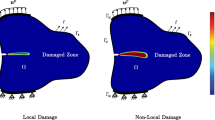Abstract
A cohesive zone model has been proposed to model crack growth with a part-through process zone in a thin solid. With the solid being modeled in Kirchhoff’s plate theory, the crack with a relatively long, inclined front is modeled as a line discontinuity with a finite cohesive zone within the plate. A cohesive force law is adopted to capture the effect of residual strength and residual rigidity of a plate cross-section gradually cracking through the thickness. It is derived by a plane-strain elasticity analysis of a cross section normal to the part-through crack. It is then applied in the plate formulation of a line crack to simulate its propagation within the plate plane. This model essentially resolves the originally three-dimensional crack problem in two hierarchical steps, i.e., in the thickness and in the in-plane directions. In the present study, the bending case is considered. A boundary element method is applied to numerically derive the cohesive force law and simulate the crack growth in a thin titanium-alloy plate. The computational efficiency of the model is demonstrated. The plate is shown to fracture in a nominally brittle or ductile manner depending on its thickness.
Similar content being viewed by others
References
Barenblatt GI (1962) The mathematical theory of equilibrium cracks in brittle fracture, advances in applied mechanics. VII, Academic Press, New York, pp 55–129
Bazant Z, Planas J (1998) Fracture and size effect in concrete and other quasibrittle materials. CRC Press, London
Bazant ZP, Cedolin L (1991) Stability of structures: elastic, inelastic, fracture, and damage theories. Oxford University Press, Oxford
Brebbia CA, Telles JCF, Wrobel LC (1984) Boundary element techniques: theory and applications in engineering. Springer, Berlin
Cirak F, Ortiz M, Pandolfi A (2005) A cohesive approach to thin—shell fracture and fragmentation. Comput Meth Appl Mech Eng 194: 2604–2618
Cook RD, Malkus DS, Plesha ME (2002) Concepts and applications of finite element analysis, 4th edn. Wiley, Hoboken
Dugdale DS (1960) Yielding in steel sheets containing slits. J Mech Phys Solids 8: 100–104
Elices M, Guinea GV, Gomez J, Planas J (2002) The cohesive zone model: advantages, limitations and challenges. Eng Fract Mech 69: 137–163
Hancock JW, Reuter WG, Parks DM (1993) Constraint and toughness parameterized by T. Am Soc Test Mat 1171: 21–40
Hillerborg A, Modeer M, Petersson PE (1976) Analysis of crack formation and crack growth in concrete by means of fracture mechanics and finite elements. Cement Concrete Res 6: 773–782
Ho S, Suo Z (1993) Tunneling cracks in constrained layers. ASME J Appl Mech 60: 890–894
Hodulak L, Kordisch H, Kunzelmann S, Sommer E (1979) Growth of part-through cracks. In: Smith SW (ed) Proceedings of the eleventh national symposium on fracture mechanics: part I. American Society for Testing and Materials
Hutchinson JW, Suo Z (1992) Mixed mode cracking in layered materials. Adv Appl Mech 29: 63–191
Knauss WG et al (1974) On the steady propagation of a crack in a viscoelastic sheet: experiment and analysis. In: Kausch HH (eds) Deformation and fracture of high polymers. Plenum Press, New York, pp 501–540
Portela A, Aliabadi MH, Rooke DP (1992) The dual boundary element method, effective implementation for crack problems. Int J Numer Meth Eng 33: 1269–1287
Shih CF, O’Dowd NP, Kirk MT (1993) A framework for quantifying crack tip constraint. Constraint Eff Fract 1171: 2–20
Tada H, Paris PC, Irwin GR (1985) The stress analysis of cracks handbook, 2nd edn. Paris production, St. Louis
Timoshenko S, Woinowsky-Krieger S (1959) Theory of plates and shells. McGraw-Hill Book Company, New York
Xu X-P, Needleman A (1994) Numerical simulations of fast crack growth in brittle solids. J Mech Phys Solids 42: 1397–1434
Yang Q, Cox B (2005) Cohesive models for damage evolution in laminated composites. Int J Fract 133: 107–137
Yang B, Ravi-Chandar K (1998) A single-domain dual-boundary-element formulation incorporating a cohesive zone model for elastostatic cracks. Int J Fract 93: 115–144
Yang B, Ravi-Chandar K (1999) Evaluation of elastic T-stress by the stress difference method. Eng Fract Mech 64: 589–605
Yang B, Mall S, Ravi-Chandar K (2001) A cohesive zone model of fatigue crack growth in quasibrittle materials. Int J Solids Struc 38: 3927–3944
Zehnder AT, Viz MJ (2005) Fracture mechanics of thin plates and shells under combined membrane, bending and twisting loads. Appl Mech Rev 58: 37–48
Author information
Authors and Affiliations
Corresponding author
Rights and permissions
About this article
Cite this article
Yang, B., Shiva, S. Crack growth with a part-through process zone in thin plates. Int J Fract 168, 145–158 (2011). https://doi.org/10.1007/s10704-010-9564-8
Received:
Accepted:
Published:
Issue Date:
DOI: https://doi.org/10.1007/s10704-010-9564-8




